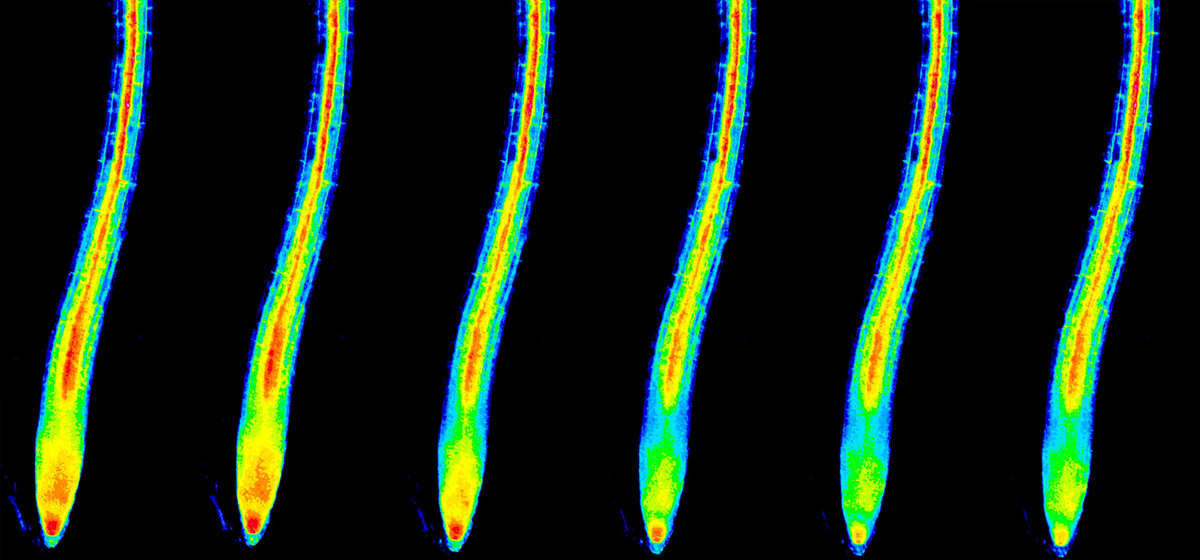
Researchers Identify Where and How Plants Detect Potassium
March 31, 2021| |
A team of German and Chinese researchers has shown, for the first time, where and how plants detect potassium deficiency in their roots, and which signaling pathways coordinate the adaptation of root growth and potassium absorption to uphold potassium supply.
The absorption and transportation of potassium at the level of individual cells have been well characterized, but it was unknown how plants detect potassium availability in the soil. The researchers looked at Arabidopsis thaliana plants which were transformed with the newly developed potassium reporter protein GEPII. This reporter protein enables the microscopic detection of the concentration and distribution of potassium ions in cells and tissues. The research team found that the concentration of potassium in the cytoplasm of the cells increased with each cell layer within the root, from the outside to the inside.
They also found that in plants subjected to potassium deficiency, the concentration of potassium is reduced only within certain cells in the root tip. These cells in the root tip react extremely rapidly to potassium deficiency and the concentration of potassium inside the cell (in the cytoplasm) decreases within seconds. It had not previously been known that a certain group of cells located centrally inside the root tip reacts to a potassium deficiency in its surroundings. The researchers named this group of cells "potassium-sensitive niche". They have also visualized the path of potassium in a living organism.
For more details, read the article in the University of Münster website.
| |
You might also like:
- Scientists Find Candidate Gene for Improving Potassium Deficiency Tolerance in Rice
- Researchers Use CRISPR to Improve Nutrient Use Efficiency of Rice
- Suberin Plays Vital Role in Plant Nutrient Absorption
Biotech Updates is a weekly newsletter of ISAAA, a not-for-profit organization. It is distributed for free to over 22,000 subscribers worldwide to inform them about the key developments in biosciences, especially in biotechnology. Your support will help us in our mission to feed the world with knowledge. You can help by donating as little as $10.
-
See more articles:
-
News from Around the World
- Biosafety and Varietal Release Authorities' Interaction Vital in Commercialization of GM Crops in Africa
- Newly Elected Leaders in Central Uganda Pledge Support for GM Crops
- Chickpea to Get Nutrition Boost from Hardy and Weedy Wild Relatives
- First Known Gene Transfer from Plant to Insect Reported
- Punjab Issues Schedule for Sowing of Registered Bt Cotton Varieties
- Biotech Experts to Tackle Impact of Agri-Biotech in Vietnam
- Study Reveals Plants Remember Drought
- Researchers Identify Where and How Plants Detect Potassium
-
Research Highlights
- Mango Genome Sequence Leads to Candidate Genes for Fruit Quality
-
Plant
- ISAAA Webinar Puts Genome Editing in the Spotlight
- CRISPR-Cas12a Expands Genome Engineering with Six Novel Variants
-
Health
- Plant-Based COVID-19 Vaccine Candidate Starts Phase 3 Trial
-
Read the latest: - Biotech Updates (December 17, 2025)
- Gene Editing Supplement (December 17, 2025)
- Gene Drive Supplement (February 22, 2023)
-
Subscribe to BU: - Share
- Tweet

